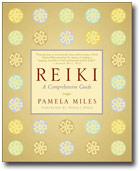Books |
Reiki: A Comprehensive Guide
Pamela Miles
By
Published: Feb 19, 2014
Category:
Health and Fitness
We tend to think any kind of healing that originated in Asia is thousands of years old. We imagine that hermetic monks took it for decades of test drives before offering it to the faithful. And then, in the background of an Eastern treatment room, someone found a picture of a venerable deity and asked a question. And in that way, the healing wisdom came to America.
So the first surprise of Reiki is that it originated with Mikao Usui, most likely in 1922. That year, he went to a Japanese sacred site to fast and meditate. He got a bonus: subtle vibrations above his head. He felt healed. More, he felt he had the power to heal. And, in short order, he taught 2,000 Japanese how to use this power.
Reiki is tricky to describe, and so the first accomplishment of this excellent guide is the description of what Reiki isn’t. It is not "energy medicine." It does not require a diagnosis. The practitioner doesn’t need to concentrate or "direct" the treatment. The practitioner need not be in the same room, or even the same city. The patient need not be awake for the treatment to work.
So what is Reiki? According to Pamela Miles — who is probably the senior Reiki master now practicing in the United States — it’s an experience. More like meditation than medicine. As she describes it, it’s powerful stuff: “Reiki opens an inner spiritual connection that can significantly change the way a person experiences life, a sense of connectedness that can help transform negative attitudes and create a sense of meaning and purpose.”
The claims are many and varied: Sleep better. Work clearer. Breathe more deeply. Enjoy better digestion. Get relief from chronic pain. Stay calm in emergencies. Live more in the moment. [To buy the paperback from Amazon, click here. To buy the Kindle edition, click here. ]
You can even treat yourself.
"The foundation of Reiki is self-healing," Miles writes. All it takes: a few simple hand placements. Aw, c’mon, you say. Pamela Miles is unapologetic on this point: "We are used to valuing effort — Reiki is effortless."
But….you must be trained. Once you’ve been trained, "you can lightly lay your hand on your head, chest, abdomen, or any place that hurts, anytime you need to regain your center, restore your well-being or relieve pain — even while you’re in a cab, watching TV, or on the phone with your mother-in-law."
Okay, but what does the practice involve? Ms. Miles is not secretive or even mysterious on this point, just honest — you can’t learn Reiki from a book. But you may badly wish her to tell you more when you read some of the stories at the end of ‘Reiki: A Comprehensive Guide.’ Like: The girl who overdosed and arrived at the hospital without any vital signs. And still had none after two hours of resuscitation. A doctor trained in Reiki put her hand on the girl’s forehead to say goodbye. The girl revived. A week later, her only symptom was a minor palsy.
By now, I bet you’re totally frustrated. How does Reiki work? "We don’t yet know," Miles says. But it does work, of that I’m convinced. Will you be? I can’t say; it depends on where you are in your life and your willingness to believe that energy vibrating from one person can be directed to heal another. And it depends on whether you read this book. My bet: if you do, you’ll want to know much, much more.
To read more about Pamela Miles and her Reiki practice, click here.
BONUS VIDEO
Pamela Miles, at length, interviewed by Jonathan Fields. Click here.


